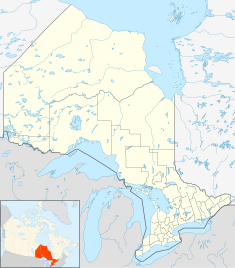| This article needs additional citations for verification. Please help improve this article by adding citations to reliable sources. Unsourced material may be challenged and removed. Find sources: "Nanticoke Refinery" – news · newspapers · books · scholar · JSTOR (August 2009) (Learn how and when to remove this message) |
 | |
| Country | Canada |
|---|---|
| Province | Ontario |
| City | Nanticoke |
| Coordinates | 42°49′59″N 80°02′45″W / 42.832926°N 80.045764°W / 42.832926; -80.045764 |
| Refinery details | |
| Operator | Imperial Oil |
| Owner(s) | Imperial Oil |
| Commissioned | 1978 (1978) |
| Capacity | 113,500 |
| Complexity index | 9.82 |
| No. of employees | 300 |
| Refining units | alkylation, distillation of crude oil, hydrocracking, reforming catalytic, cracking catalytic, desulphuration, hydrofining |
| No. of oil tanks | 53 |
| Oil refining center | Nanticoke |
The Nanticoke Refinery is an oil refinery in Nanticoke, Ontario, Canada. It is owned and operated by Imperial Oil, which is majority owned by ExxonMobil. The refuels primarily go to Esso-branded gas stations in Canada and to other oil companies' distribution networks in Canada and the United States.
History
Nanticoke refinery was originally built by Texaco Canada on the site of the former RCAF Station Jarvis. It started production on November 17, 1978. In 1987, the refinery went through modifications to improve efficiency. Imperial Oil became an owner of the refinery when it purchased Texaco's Canadian assets in 1989.
In 2004, a new gasoline hydrofining unit was built to treat gasoline ingredients from the Nanticoke and Sarnia refineries, followed by the second unit in 2006. A new desulphurization unit was commissioned in 2006.
In February 2007, a combination of a fire at the Nanticoke refinery and a strike at CN resulted in a shortage of gasoline at Esso stations in Ontario, which also drove up prices to more than a dollar a litre. Strangely, the fire had been discovered quickly but the fire suppression systems were not operating, and the handheld fire extinguishers had a faulty charge. Damage to the facility was made inevitable when the on-site fire brigade ran out of gas while en route to the location.
Operating units
According to the Oil & Gas Journal, Sarnia has the following units in operation:
| Unit | Capacity Bbl/day |
|---|---|
| Total Refinery Nameplate Capacity | 113,500 |
| Atmospheric Distillation | 113,500 |
| Vacuum Distillation | 48,000 |
| FCC | 48,500 |
| Naphtha Reformer | 33,500 |
| Naphtha Hydrotreater | 25,500 |
| Gasoline Hydrotreating | 44,000 |
| ULSD Hydrotreater | 29,500 |
| Alkylation | 12,000 |
The Nanticoke Refinery is geared towards gasoline production with a large fluid cat cracking and an alkylation unit for producing high octane gasoline components.
The Refinery has a Nelson Complexity Index of 9.82, making it moderately to highly complex.
Emissions
Greenhouse gas emissions
The refinery's performance can be tracked on the Government of Canada's website for emissions. The chart below provides the GhG performance in 2022:
Facility emissions for 2022
| Gas | Sum (tonnes) | Sum (tonnes CO2 eq ) |
|---|---|---|
| CO2 | 1,140,309 | 1,140,309 |
| CH4 | 301 | 8,434 |
| N2O | 15.8 | 4,185 |
| HFCs | 0 | 0 |
| PFCs | 0 | 0 |
| SF6 | 0 | 0 |
| Total : | 1,152,928 | |
| Year | Emissions
(tonnes CO2 eq) |
|---|---|
| 2004 | 1,218,742 |
| 2005 | 1,304,098 |
| 2006 | 1,095,158 |
| 2007 | 1,131,382 |
| 2008 | 1,050,990 |
| 2009 | 1,067,616 |
| 2010 | 1,068,317 |
| 2011 | 1,024,786 |
| 2012 | 1,080,711 |
| 2013 | 1,077,567 |
| 2014 | 1,158,633 |
| 2015 | 1,116,301 |
| 2016 | 1,081,117 |
| 2017 | 951,177 |
| 2018 | 1,197,716 |
| 2019 | 962,222 |
| 2020 | 1,064,707 |
| 2021 | 1,130,330 |
| 2022 | 1,152,928 |
Labor relations
The Imperial Nanticoke Refinery's workforce is represented by Unifor Local 900.
Operating history and accidents
The refinery experienced a fire in February of 2007 in its crude unit. This caused major concerns for the region due to the dearth of supply in late winter to the Toronto metro area. Gasoline prices increased considerably as a result in late February (to more than $1 CAD per liter). The quick return of the refinery to production was handicapped by the CN Rail strike. By mid-March, the refinery was back into full production.
See also
References
- "Nanticoke Refinery: A Report to our Neighbors" (PDF). Imperial Oil. August 2007. Retrieved 28 October 2014.
- "Nanticoke Refinery: 2007 Report to Our Neighbors" (PDF). Imperial Oil. September 2008. Archived from the original (PDF) on 28 October 2014. Retrieved 28 October 2014.
- John Burman (2007-02-12). "Nanticoke derailment forces evacuation". The Hamilton Spectator. Teamsters Canada Rail Conference. Archived from the original on 2011-07-06. Retrieved 2009-08-11.
- "Worldwide Refining". Oil & Gas Journal. Retrieved 2024-11-25.
- "Refinery profile: Nanticoke cracking refinery, Canada". Offshore Technology. 2021-10-27. Retrieved 2024-11-25.
- "Canadian Environmental Sustainability Indicators - Canada.ca". indicators-map.canada.ca. Retrieved 2024-11-25.
- ^ "Greenhouse Gas Reporting Program data search: facility information". Government of Canada.
- "Unifor reaches tentative agreement with Imperial Oil | Unifor". www.unifor.org. 2017-05-16. Retrieved 2024-11-25.
- "Gas shortage hits Imperial Oil outlets after refinery fire". The Globe and Mail. 2007-02-21. Retrieved 2024-11-25.
- "Gas woes spread as price passes a dollar". The Globe and Mail. 2007-02-27. Retrieved 2024-11-25.
- Beltrame, Julian (2007-04-18). "Refinery fire, CN walkout derail orders". Toronto Star. Retrieved 2024-11-25.
- "Imperial wraps up repairs to Nanticoke refinery". Reuters. 2007.